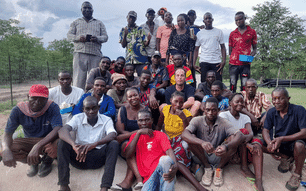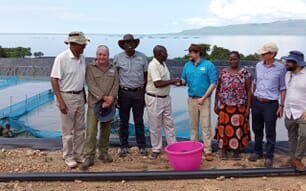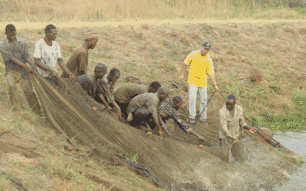
© Libens Image
According to Steve Moran, there’s never been a better time to be producing fish in Africa.
“The demand is immense, population growth isn’t slowing down, there’s a huge animal protein deficit and tilapia has an incredible potential to fulfil that protein gap sustainably. As they’re omnivores they don’t need significant amounts of animal protein or fish oil in their feeds,” he says.
As the co-founder and group chief aquaculture officer for Victory Farms in Kenya and Kivu Choice in Rwanda – which are on track to produce 18,000 and 2,000 tonnes of tilapia this year respectively – as well as a former general manager of Tropo Farms in Ghana, Moran knows a thing or two about Nile tilapia and is a firm believer in the role the species can play in feeding the continent.
“We’ve built the largest fish farms in Kenya and Rwanda, and of course we’ve got plans to continue growing in both countries and beyond, but we’re still only just scratching the surface of the demand,” he reflects.
Moran’s sentiments are echoed by Kamran Ahmad, co-founder and CEO of Kivu Choice, who is overseeing the growth of Victory’s Rwandan sister company. Less than two years since their first fish were stocked in cages in Lake Kivu, he has ambitions to grow the business to well over 20,000 tonnes a year before the end of the decade.
“The reason we do what we do is that tilapia, farmed right, has the potential to be the most affordable animal protein in the markets that we’re operating in. Even now, in Rwanda, although we’re early in the game, our fish is now the most affordable animal protein in the country – particularly for our smaller sized fish. Chicken and beef are in the range of $2.5 to $3 per kilo, while on the smaller sizes of tilapia we’re below $2,” he reflects.
The reasoning behind their decision to start selling smaller fish is clear – they’re much more efficient to produce and therefore much more affordable for local consumers. This discovery was supported by research by Victory, in partnership with the University of Stirling - funded by KTN Agrifood Africa and Nutreco - which found that producing a greater number of smaller fish using a partial harvest system increased the overall biomass and efficiency of the system and made the fish more affordable.
“When we first started in Kenya we were selling at 450-500 g and last year we averaged around 380 g. As we reduce the target size of harvested fish it opens up more of the market as it becomes a regularly affordable protein for people, so the potential there is immense,” Moran explains.
It’s a tactic that has begun to pay off in Rwanda too.
“The other commercial farms in Rwanda are typically producing fish of 1 kg-plus for the hotels and supermarkets, but we came in with fish of 400-450 g and want to drive it down even further. At first it was a struggle and we had to actively cultivate that market segment, but now people are starting to see the value of it,” reflects Ahmad.
“You increase the throughput through your cages as well as the efficiency of production – smaller fish have better Feed Conversion Ratios and result in better asset utilisation,” he adds.
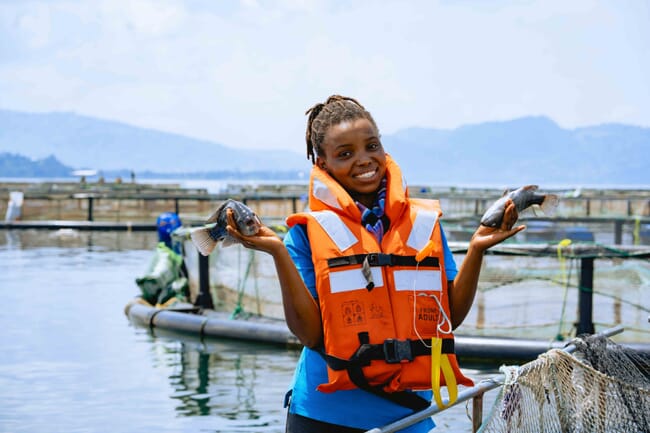
© Libens Image
This approach also means that they are able to grow two-and-a-half cycles of fish in their cages each year.
“Egg to table is about 10 months, but only about 150 days are in the production units [cages]. It’s getting better every year as we shave a bit off every generation with improved genetics,” notes Moran.
On the flip side it means that they have had to invest more in their hatchery operations, but that’s a hit they’re prepared to take.
“When you’re limited in terms of fingerling supply you grow your fish big because that’s how you get volume. But because we’ve invested a lot in getting excess capacity on the hatchery side it allows us to produce smaller and smaller fish,” Moran explains.
Feed improvements
As well as reducing the size of their fish, production costs have also been helped by the growth of the local aquafeed network.
“Within the next 18 months we’re going to have the capacity for 150,000 to 200,000 tonnes in the region and with this localised feed the cost of production is falling really, really quickly. We’re not quite there yet but we’re almost able to compete with imported Chinese tilapia in terms of price,” Moran points out.
“In our better performing months we’re in striking distance, as we get more consistent and build better systems we’ll get there,” agrees Ahmad.
Part of this new feed availability is coming from Victory’s own feed mill, SamakGro, which started production in September.
“The biological performance we’re seeing on the feed is actually better than the competitors – in terms of FCRs and growth rates,” notes Moran.
“Tunga and Sigma are also increasing their capacity – there are new mills in Uganda and Rwanda, as well as older mills in Zambia, which is making it a really competitive environment. Driving quality up and price down,” he adds.
Meanwhile, they are also looking to increase the proportion of locally-grown ingredients – including indigenous African ones – being used in their feeds, which could help to further reduce costs and also bring sustainability benefits compared to importing ingredients from further afield.
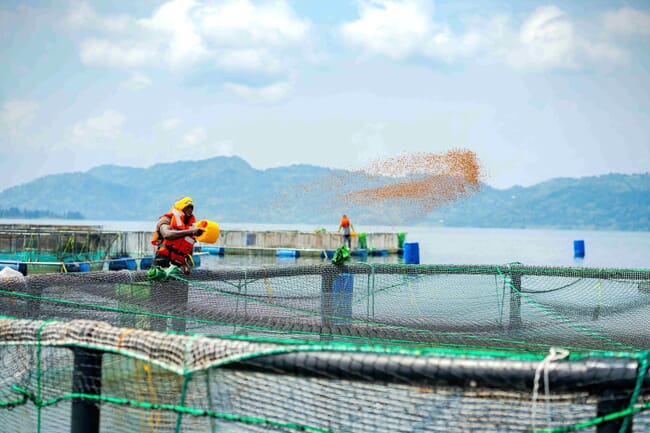
© Libens Image
Rwandan operations
The process for establishing Kivu Choice, the sister company of Victory, began with a long-term lease of a hatchery, which is now producing around two thirds of the country's fingerling supply.
“That side of our business is beginning to grow, we’re also targeting 10,000 tonnes by the end of next year and are about to start constructing more farm sites. We’re now employing around 300 people – it’s growing very quickly. The whole production system is very similar to our Kenya operation’s – we’ve replicated a successful model, using most of the same systems and protocols,” says Ahmad.
“There’s a degree of geographical nuance to it – the hatchery is a five hour drive from the lake, whereas in Kenya it’s a 5 minute drive – but it’s essentially the same practice and protocols,” adds Moran.
Having two operations is proving to be useful, as the company grows.
“We have Rwandans doing training in Kenya and equally we have Kenyans training and developing the Rwanda team – the biggest constraint is always people,” Moran reflects.
A comparison with Kenya
In terms of the actual farming, Moran notes that their operations are broadly similar, although Lake Kivu – which is 600 m deep – is a couple of degrees cooler that Lake Victoria and considerably less eutrophic.
“There’s a degree of seasonality of our production on Lake Victoria, which is driven by the algae blooms, whereas in Lake Kivu the visibility is regularly 6 to 10 metres – it’s nigh on pristine for 12 months of the year,” he explains.
“Lake Victoria is effectively a freshwater sea. There are strong currents and, when the wind blows, there are 2, 3, 4 metre waves. Kivu is long and thin and you don’t get the same wave action, but on the flip side this means you get less mixing and so we have to stock at lower densities,” he adds.

© Libens Image
According to Ahmad, many people thought that it wouldn’t be feasible to run a tilapia hatchery in Southern Rwanda, due to the comparatively low temperatures of the ponds.
“Lake Kivu’s on a geothermal energy source, so is naturally around 25 °C year-round, but the ponds can get down to 18° C or so and, according to the textbooks, tilapia won’t breed in those conditions. But we continue to achieve egg yields at least on a par with what we get in Kenya,” explains Ahmad.
“When we started in Rwanda we were budgeting to put hundreds of thousand of dollars of greenhouses over our ponds, but it turned out not to be an issue,” he adds.
Grow-out times are currently marginally better in their Rwandan operations than their Kenyan ones.
“We’re still learning the lakes, we’ve only been farming for about 18 months in Kivu – we were working at the hatchery prior to that – so we’re still building up that experience,” explains Moran.
In both locations they are helping to catalyse the growth of the industry.
“They’re nascent industries in both countries. Kenya is six to ten years ahead, but it’s still very small, while Rwanda only has three or four other players producing between 50 and 600 tonnes,” notes Moran.
“We’re targeting a level and scale of production that’s yet to be seen in the country–the whole farmed aquaculture sector was around 4,000 tonnes when we founded the company and we’re targeting 20,000 tonnes in the next few years. One of the big reasons that we’re confident that we can achieve this pace of growth is the collaboration we’ve had with the Rwandan government – they’re very agile and when they prioritise something they’re able to make it happen very quickly. For example, when we put in our proposal to take over the hatchery it took less than six months between submitting the application and receiving the lease,” adds Ahmad.
Sales channels
While Victory sell 95 percent of their Kenyan fish domestically through their own sales network of nearly 100 branches, in Rwanda they are exporting 60 percent to the Democratic Republic of Congo through third party traders, while 40 percent goes through their 15 sales outlets in Rwanda.
“Both the Rwandan and Congolese markets have some of the highest fish prices in the region, and there are very few players in the market supplying fresh fish,” Ahmad reflects.

© Libens Image
Scaling up in Rwanda
Ahmad is currently overseeing the buildout of Kivu Choice’s hatchery and production sites, which are quite widely spread across the Southern and Western Provinces of Rwanda.
“We’re operating out of a temporary base at the moment, to continue to scale we need to build industrialised piers, feed warehousing, cold chain – construction of our core farm site on Kivu is going to start in the next couple of weeks – and we’re also scaling up our Rwandan outlets. We’re hoping to get to somewhere in the range of 30-40 branches towards the end of next year,” he notes.
Like in Kenya, they are also keen to ensure that this scaling doesn’t lead to environmental degradation.
“We’ve done a baseline study of the biodiversity around our farm sites in Rwanda and we’ll be trying to increase the levels – through indigenous tree plantations and protecting the lake around our cage concessions. We’re doing the same thing as we’ve successfully implemented in Kenya on this front, where we’re seeing a proliferation of species,” says Ahmad.
“It’s our belief that tilapia farming should be net positive for biodiversity, net positive for the environment, feeding people at the same time. We can build it the right way, when we work hand-in-hand with communities and other stakeholders, other farms, industry associations and with government frameworks,” adds Moran.
Having raised $35 million in series B funding in 2023, the team are now actively following through on their ambitious growth plans. “We’ve demonstrated that we can scale rapidly whilst maintaining environmental as well as financial sustainability at the forefront of our operations. At this time Kenya is profitable despite growing 40% year on year, and we’re targeting profitability in Rwanda next year, in what will only be our third year of operation.” Ahmad concludes.

